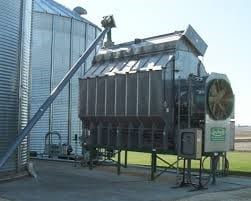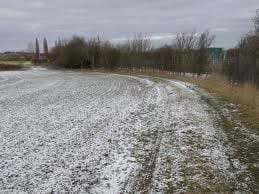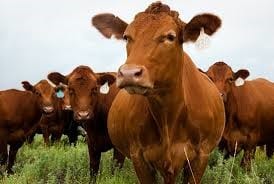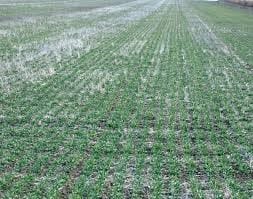Hello,
I hope you had a good Thanksgiving with your family. Did you hear that the turkeys pardoned by the President were from Cooper Farms in Ohio? See the attached article written by Hancock County Extension Educator Ed Lentz about the White House turkey pardon, which also includes some interesting information about turkey production in Ohio as well. I had the opportunity to share in the Thanksgiving holiday with my family and also topped the weekend off by witnessing the OSU-Michigan game victory at Ohio Stadium.
Now it is time to get back to work as there are many things coming up soon that you may be interested in attending. First of all is the Agriculture Hall of Fame Banquet Tuesday, December 2. This year Edward Althauser, Gene Haudenschield, Bruce McCullough, and J. Ray Parrott will be inducted. The program will begin at 6:30 pm at St. John’s United Church of Christ. The guest speaker will be Gary Wilson, who recently retired as the OSU Extension Educator in Hancock County. See the attached news release for further information.
2014 Ag Hall of Fame News Release
Have you seen the video about the cover crops signs being put up by the Natural Resources Conservation Service (NRCS) and sponsored by Ag Credit? Hardin County NRCS District Conservationist Megan Burgess is featured with local farmer and Soil and Water Conservation District (SWCD) Chairman Jerry McBride in this video that can be viewed at http://youtu.be/Pxc4c6H1Sc0. These signs are to help the public see how cover crops can be part of the solution to the harmful algae blooms in the western Lake Erie basin watershed. In a related matter, Congressman Latta sponsored a bill to help protect drinking water from cyanotoxins, which are a product of this problem. See the attached file for more details about Congressman Latta’s legislation.
Latta Introduces Bill to Help Protect Drinking Water
Other upcoming events include the Cattle Producers Directors meeting on Wednesday, December 3. The meeting will start at 7:30 pm at the Allmax Software building. The Dairy Service Unit Directors will meet Thursday, December 4. This meeting will start at 7:00 pm at the fairgrounds office. Ag Council will meet Friday, December 5, starting at 7:00 am. This meeting will include breakfast at Henry’s Restaurant. The Fairboard will meet Saturday, December 6, starting at 7:30 pm. They will meet in the fairgrounds office. The Sheep Tour group Christmas dinner and evaluation meeting will be held Sunday, December 7, starting at 1:00 pm. This gathering will be held at Larry and Ruth Inbody’s farm. I have included some articles below that you may be interested in reading.
Mark
Cold Weather and Fall Herbicides – to spray or not to spray – Mark Loux
It’s always amazing to see apparently still thriving winter annual weeds underneath the snow or following some really cold weather. Even the dandelions in the lawn appeared healthy yesterday, although they can be one of the first weeds to turn purple following really cold weather. Their healthy appearance and lack of symptomology is actually somewhat disturbing since I treated them just prior to the recent deep freeze and had higher expectations. Our best advice at this point on fall spraying is that once fields dry or freeze up enough to allow traffic again, there is still considerable benefit to applying herbicides for control of marestail and other weeds that persist through winter. Go to http://corn.osu.edu/newsletters/2014/2014-39/cold-weather-and-fall-herbicides-to-spray-or-not-to-spray to finish reading this article.
Temperature Management in On-farm Grain Bins – Curtis Young
There are recommended targets for percent grain moisture and grain temperature for winter grain bin storage. Targeted percent grain moisture contents should be attained through a combination of one or several of the following: natural field maturation and drying, grain dryer, and bin drying using aeration fans. The higher the percent moisture content of the grain coming out of the field, the greater the necessity to use heat producing dryer systems. After grain is dried to an acceptable percent grain moisture content, it needs to be cooled to the appropriate temperature for storage. Go to http://corn.osu.edu/newsletters/2014/2014-39/temperature-management-in-on-farm-grain-bins to continue reading about temperature management in on-farm grain bins.
Winter Weather Outlook – Jim Noel
November will go down as a top 10 coldest November most likely with drier than normal precipitation and snowier than normal. If you look at the 10 coldest Novembers, the December to February period that follows is usually near normal temperatures and slightly wetter than normal precipitation but with a lot of changes and extreme within that period. The big high pressure in Alaska that drove cold air into the U.S. is forecast to breakdown and be replaced by more typical low pressure. This will allow for a more westerly flow pattern into a good part of December meaning temperatures will be near to slightly above normal the next 3-4 weeks. At the same time, the dry northwest flow will be replaced by a more active pattern yield normal or slightly wetter than normal conditions in Ohio the next 3-4 weeks. Go to http://corn.osu.edu/newsletters/2014/2014-39/winter-weather-outlook to get the full update on the winter weather outlook.
Cold Spring Rains Brought Perfect Conditions for Pythium in Ohio and a Few More Surprises – Anne Dorrance
From many of the samples we recovered both Pythium spp. and Fusarium spp.. Both are well-known seedling pathogens. Our next step was to examine what the Pythium spp. were and then to determine if these were sensitive to metalaxyl. In approximately 60% of the locations we were able to obtain a good quality sequence and a metalaxyl test for 28 isolates. From many of the samples we recovered both Pythium spp. and Fusarium spp. Both are well-known seedling pathogens. Our next step was to examine what the Pythium spp. were and then to determine if these were sensitive to metalaxyl. In approximately 60% of the locations we were able to obtain a good quality sequence and a metalaxyl test for 28 isolates. Go to http://corn.osu.edu/newsletters/2014/2014-39/cold-spring-rains-brought-perfect-conditions-for-pythium-in-ohio-and-a-few-more-surprises to read more about the diverse pathogens affecting Ohio corn and soybean seedlings.
So you want to be a CCA – Harold Watters
The next North American Certified Crop Adviser Exam Date is February 6, 2015. The registration period closes on December 5, 2014. Keep in mind, to become eligible for the CCA certification, you must take and pass both the North American and the local (state/province) board exams. For us in Ohio, Indiana and Illinois that is the Tri-State exam – a group of educators and practicing CCAs from each state gather regularly to update and verify the exam. For more information and to register, see this website: https://www.certifiedcropadviser.org/exams/registration. The cost for the International (for us North American) exam is $175 and the Tri-state exam is $50. You must be registered to take either exam. The Ohio site for the February 6th CCA exam is Marysville at the Union County Services Building on south London Avenue (SR 38). For more information about what to study and how to become a Certified Crop Adviser, go to http://corn.osu.edu/newsletters/2014/2014-39/so-you-want-to-be-a-cca.
Mark A. Badertscher
Agriculture and Natural Resources Educator
OSU Extension Hardin County
1021 W. Lima Street, Suite 103, Kenton, OH 43326
419-674-2297 Office
















